Radioactive nuclide - Study guides, Class notes & Summaries
Looking for the best study guides, study notes and summaries about Radioactive nuclide? On this page you'll find 67 study documents about Radioactive nuclide.
Page 2 out of 67 results
Sort by

-
NMTCB Board Prep Questions and Answers
- Exam (elaborations) • 33 pages • 2024
- Available in package deal
-
- $14.49
- + learn more
NMTCB Board Prep Questions and Answers Nuclides with the same atomic number ( the same number of protons) but a different number of neutrons are called: - Answer ️️ -isotopes Two nuclides with the same atomic mass but different atomic numbers are called: - Answer ️️ - isobars A nuclide that emits particulate or photon energy to achieve a more stable state: - Answer ️️ - radionuclide Another name for a helium ion containing two protons and two neutrons: - Answer ️️ -alpha ...
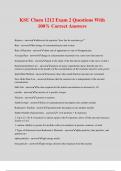
-
KSU Chem 1212 Exam 2 Questions With 100% Correct Answers
- Exam (elaborations) • 2 pages • 2024
-
- $10.49
- + learn more
KSU Chem 1212 Exam 2 Questions With 100% Correct Answers Kinetics - answeraddresses the question "how fast do reactions go?" Rate - answerthe change of concentration per unit in time Rate of Reaction - answereither rate of appearance or rate of disappearance Average Rate - answerchange in concentration measured over a non-zero time interval Instantaneous Rate - answerequal to the slope of the line drawn tangent to the curve at time t Experimental Rate Law - answeranalysis of many experi...
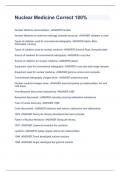
-
Nuclear Medicine Correct 100%
- Exam (elaborations) • 5 pages • 2024
- Available in package deal
-
- $10.49
- + learn more
Nuclear Medicine demonstrates: -ANSWER function Nuclear Medicine is under the radiology umbrella because: -ANSWER radiation is used Types of radiation used for conventional radiography -ANSWER Alpha, Beta, Particulate, Ionizing Types of radiation used for nuclear medicine -ANSWER Gamma Rays, Nonparticulate Source of radiation for conventional radiography -ANSWER x-ray tube Source of radiation for nuclear medicine -ANSWER patient Equipment used for conventional radiography -ANSW...
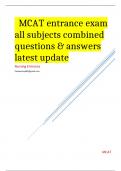
-
MCAT entrance exam all subjects combined questions & answers latest update
- Exam (elaborations) • 196 pages • 2023
- Available in package deal
-
- $15.99
- 3x sold
- + learn more
m 1. Which of the following is the mRNA start codon in most cases? A. UAA B. AGU C. AUG D. UGA 2. Which of the types of RNA is the smallest? A. mRNA B. tRNA C. rRNA D. 3. Which of the following is not considered a pyrimidine? A. C B. T C. U D. G 4. Which of the following is paired correctly? A. A-G B. C-G C. A-U D. G-T 5. Which of the following characterizes a Western blot? A. Antibody/protein hybridization B. DNA/RNA combination C. RNA ...
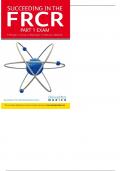
-
Succeeding in the Frcr Part 1 Exam
- Exam (elaborations) • 262 pages • 2024
-
- $21.39
- + learn more
Chapter 1 Basic Atomic Structure, Radioactive Decay Please answer all questions True or False. There is no negative marking. 1. Concerning the nucleus of atoms a. It is made up of protons and electrons b. It is made up of protons and neutrons c. Nucleons are held together by the strong nuclear force d. The mass number represents the number of protons e. The number of protons and neutrons is always equal The nucleus of an atom is composed of protons and neutrons. The charge of...
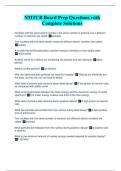
-
NMTCB Board Prep Questions with Complete Solutions
- Exam (elaborations) • 35 pages • 2024
- Available in package deal
-
- $15.49
- + learn more
Nuclides with the same atomic number ( the same number of protons) but a different number of neutrons are called: isotopes Two nuclides with the same atomic mass but different atomic numbers are called: isobars A nuclide that emits particulate or photon energy to achieve a more stable state: radionuclide Another name for a helium ion containing two protons and two neutrons: alpha particle What is a beta particle? an electron Why are alpha and beta particles not used for imaging? T...
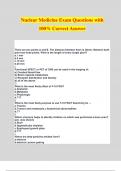
-
Nuclear Medicine Exam Questions with 100% Correct Answer
- Exam (elaborations) • 54 pages • 2024
- Available in package deal
-
- $14.49
- + learn more
Nuclear Medicine Exam Questions with 100% Correct Answer There are two points A and B. The distance between them is 30mm. Between both point are three pixels. What is the length of every single pixel? a.1 mm b.5 mm c.10 mm d.30 mm c Functional SPECT or PET of CNS can be used in the imaging of: a) Cerebral blood flow b) Brain regional metabolism c) Receptor distribution and density d) all of the above D What is the most likely effect of F-18 FDG? a.Anatomic b.Metabolic c.Physiol...
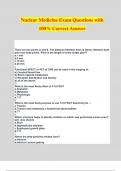
-
Nuclear Medicine Exam Questions with 100% Correct Answer
- Exam (elaborations) • 54 pages • 2024
- Available in package deal
-
- $14.49
- + learn more
Nuclear Medicine Exam Questions with 100% Correct Answer There are two points A and B. The distance between them is 30mm. Between both point are three pixels. What is the length of every single pixel? a.1 mm b.5 mm c.10 mm d.30 mm c Functional SPECT or PET of CNS can be used in the imaging of: a) Cerebral blood flow b) Brain regional metabolism c) Receptor distribution and density d) all of the above D What is the most likely effect of F-18 FDG? a.Anatomic b.Metabolic c.Physiol...
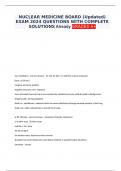
-
NUCLEAR MEDICINE BOARD (Updated) EXAM 2024 QUESTIONS WITH COMPLETE SOLUTIONS Already GRADED A+
- Exam (elaborations) • 23 pages • 2024
- Available in package deal
-
- $13.39
- + learn more
NUCLEAR MEDICINE BOARD (Updated) EXAM 2024 QUESTIONS WITH COMPLETE SOLUTIONS Already GRADED A+ Questions & Answer Such As: What do nuclear medicine tests assess accurately? - Answer - function What is the most common radioactive nuclide? - Answer - Technetium-99 (Tc-99m)

-
Abeka Chemistry Test 11 fully solved exam study guide 2024-2025(100% accurate expert solutions)download to pass
- Exam (elaborations) • 6 pages • 2024
- Available in package deal
-
- $15.49
- + learn more
SHORT ANSWER I: the process iron undergoes in the reaction Fe³⁺(aq) + 3 e⁻ → Fe(s) reduction* always occurs at the cathode reduction* Brainpower Read More Previous Play Next Rewind 10 seconds Move forward 10 seconds Unmute 0:00 / 0:15 Full screen involves a gain of electrons reduction* involves a loss of electrons oxidation* Always occurs at the anode oxidation* the process zinc undergoes in the reaction Zn(s) → Zn²⁺(aq) + 2 e⁻...

How did he do that? By selling his study resources on Stuvia. Try it yourself! Discover all about earning on Stuvia


